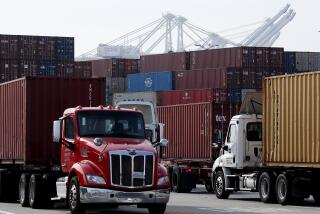Exxon Valdez Exits San Diego With New Name
- Share via
SAN DIEGO — Delayed first by environmentalists and then by the environment itself, the former Exxon Valdez left San Diego Bay six hours later than planned Wednesday, returning to service after 14 months of repairs with a new name, a new route and yet another encounter with Greenpeace under its belt.
In an elaborate pre-dawn send-off, members of the environmental activist group scaled the side of the tanker, rechristened the Exxon Mediterranean, and unfurled a banner that read “Sane Energy: When?” Two demonstrators, handcuffed to each other, perched atop the huge rudder, while six more attempted to block the ship’s passage by forming a human oil boom in the chilly water.
San Diego Harbor Police officers quickly quashed the demonstration, arresting nine of an estimated 40 protesters, according to Chief Arthur Le Blanc. But by the time divers could confirm that demonstrators had not damaged the newly repaired hull of the tanker that caused the nation’s worst oil spill, Exxon faced another problem: fog.
“It was thick. Two hundred feet from the pier, (the ship) disappeared,” said Fred Hallett, the vice president of National Steel & Shipbuilding Co., where the ship was built and received $30 million in repairs. “Somebody said, ‘She’s gone.’ And then the captain held her out in the channel for more than an hour.”
At noon, after the fog lifted, the 987-foot Exxon Mediterranean finally set sail for Singapore--its first stop before heading to the Middle East.
In July, Exxon officials announced that because of a declining need to transport Alaskan crude oil, the embattled tanker would become the first U.S.-licensed tanker to enter foreign service. It will load Middle Eastern oil in the Mediterranean and deliver it to Europe, officials said.
Critics charged that the reassignment was a public relations move designed to distance the ship from Alaska’s Prince William Sound, where it ran aground on March 24, 1989, spilling 11 million gallons of crude oil and tearing up one-third of its hull.
But Exxon officials said good business sense, not image-building, predicated the change. On Wednesday, Les Rogers, a spokesman for Exxon Shipping Co., seemed unfazed by the protests and delays, saying he was just pleased that the vessel was on its way.
“We’re ready for the voyage,” he said, noting that the Mediterranean had demonstrated its seaworthiness in 10 days of ocean trials that ended last week.
More to Read
Sign up for Essential California
The most important California stories and recommendations in your inbox every morning.
You may occasionally receive promotional content from the Los Angeles Times.













